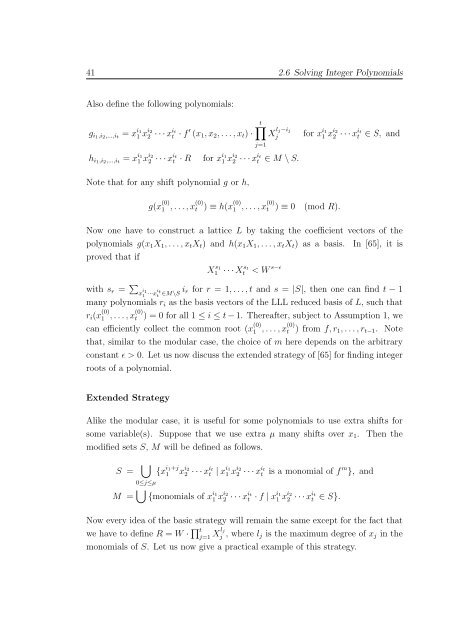Cryptanalysis of RSA Factorization - Library(ISI Kolkata) - Indian ...
Cryptanalysis of RSA Factorization - Library(ISI Kolkata) - Indian ...
Cryptanalysis of RSA Factorization - Library(ISI Kolkata) - Indian ...
Create successful ePaper yourself
Turn your PDF publications into a flip-book with our unique Google optimized e-Paper software.
41 2.6 Solving Integer Polynomials<br />
Also define the following polynomials:<br />
g i1 ,i 2 ,...,i t<br />
= x i 1<br />
1 x i 2<br />
2 ···x it<br />
t ·f ′ (x 1 ,x 2 ,...,x t )·<br />
t∏<br />
j=1<br />
h i1 ,i 2 ,...,i t<br />
= x i 1<br />
1 x i 2<br />
2 ···x it<br />
t ·R for x i 1<br />
1 x i 2<br />
2 ···x it<br />
t ∈ M \S.<br />
Note that for any shift polynomial g or h,<br />
X l j−i j<br />
j for x i 1<br />
1 x i 2<br />
2 ···x it<br />
t ∈ S, and<br />
g(x (0)<br />
1 ,...,x (0)<br />
t ) ≡ h(x (0)<br />
1 ,...,x (0)<br />
t ) ≡ 0 (mod R).<br />
Now one have to construct a lattice L by taking the coefficient vectors <strong>of</strong> the<br />
polynomials g(x 1 X 1 ,...,x t X t ) and h(x 1 X 1 ,...,x t X t ) as a basis. In [65], it is<br />
proved that if<br />
X s 1<br />
1 ···X st<br />
t < W s−ǫ<br />
with s r = ∑ x i i 1<br />
1 ···x i t<br />
t ∈M\S r for r = 1,...,t and s = |S|, then one can find t − 1<br />
many polynomials r i as the basis vectors <strong>of</strong> the LLL reduced basis <strong>of</strong> L, such that<br />
r i (x (0)<br />
1 ,...,x (0)<br />
t ) = 0 for all 1 ≤ i ≤ t−1. Thereafter, subject to Assumption 1, we<br />
can efficiently collect the common root (x (0)<br />
1 ,...,x (0)<br />
t ) from f,r 1 ,...,r t−1 . Note<br />
that, similar to the modular case, the choice <strong>of</strong> m here depends on the arbitrary<br />
constant ǫ > 0. Let us now discuss the extended strategy <strong>of</strong> [65] for finding integer<br />
roots <strong>of</strong> a polynomial.<br />
Extended Strategy<br />
Alike the modular case, it is useful for some polynomials to use extra shifts for<br />
some variable(s). Suppose that we use extra µ many shifts over x 1 . Then the<br />
modified sets S, M will be defined as follows.<br />
S = ⋃<br />
{x i 1+j<br />
1 x i 2<br />
0≤j≤µ<br />
2 ···x it<br />
t |x i 1<br />
1 x i 2<br />
2 ···x it<br />
t is a monomial <strong>of</strong> f m }, and<br />
M = ⋃ {monomials <strong>of</strong> x i 1<br />
1 x i 2<br />
2 ···x it<br />
t ·f |x i 1<br />
1 x i 2<br />
2 ···x it<br />
t ∈ S}.<br />
Now every idea <strong>of</strong> the basic strategy will remain the same except for the fact that<br />
we have to define R = W ·∏t<br />
j=1 Xl j<br />
j , where l j is the maximum degree <strong>of</strong> x j in the<br />
monomials <strong>of</strong> S. Let us now give a practical example <strong>of</strong> this strategy.
















